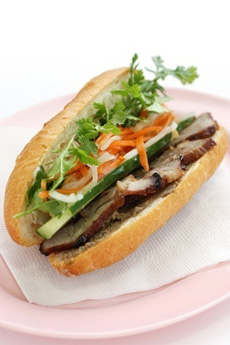How To Make A Bánh Mì Sandwich & Banh Mi History
|
|
A BRIEF HISTORY OF BANH MI SANDWICHES When Europeans colonized Asia, they brought Western bread to the table. In French Indochina, Vietnam, that emblem of French cuisine, the baguette, was introduced; as were sandwiches. Baguette-based sandwiches were called bánh mì (pronounced bon MEE), a Vietnamese word that refers to all types of bread. For sandwiches, it is made in individual portions, like hero sandwich rolls. The recipe is more airy than the conventional baguette, with a thinner crust. It actually uses a combination of rice and wheat flours, cutting back on the gluten. In recent years, bánh mì have made their way west, to the U.S. From hole-in-the-wall bánh mì sandwich shops to trendy lunch bistros to Whole Foods Markets, these fresh, tasty sandwiches have become the rage in neighborhoods lucky enough to have them. More often than not, pork is the meat of choice. But the defining characteristics of these sandwiches are their abundance of pickled vegetables and fresh herbs. Chef Johnny Gnall shares the basics of making bánh mì—just in time to serve them as Super Bowl fare. |
|
|
THE INGREDIENTS: BREAD Some cooks hold that the bread is the most important part of this sandwich, so go out of your way to find the right type. If you don’t live near a Vietnamese bakery or grocer, look for semolina flour rolls, which give you more room for fillings than a classic baguette. The roll should be crisp on the outside (if not, then juices from the ingredients will make it soggy) and very soft on the inside. Vietnamese bakeries create a roll that is more crust than center (as opposed to American breads that tend to be the opposite). So if you have a roll with an excess of soft white inside, tear some out: You want as much room for your fillings as possible! PORK Braised is the name of the game here: a slow braised pork shoulder works great, cooked to the point that you can pull it apart. The seasoning is up to you, but there’s nothing wrong with keeping it simple: salt, pepper, maybe a few chiles. Once the pork is mouthwateringly tender, pull it apart so that you can build layers easily. Let it drain for a few minutes to remove wetness that will create a mushy sandwich. PICKLED VEGETABLES Here’s an easy recipe to pickle vegetables. As for choice of vegetables, you can’t go wrong with carrots and cucumbers. You can julienne both or, for contrast, thinly slice the cucumber in circles. Radishes are also a great addition; red bell peppers add color; and pickled onions make almost anything better. FRESH CILANTRO You really won’t find a bánh mì sandwich without cilantro. Its leafy, flavorful goodness helps to round out the other flavors in the sandwich and makes it taste just right. But if you are not a cilantro fan, follow your own path by substituting other fresh herbs. Basil, mint or parsley will do the trick. Spread Every sandwich needs a spread. Chef Johnny’s favorite for bánh mì is sambal– (chile paste) or sriracha– (hot sauce) flavored aïoli (garlic mayonnaise). Just whisk together aïoli (store bought mayo works fine, whether or not you add garlic) and your preferred amount of the spicy paste or sauce. If spicy isn’t your thing, try honey, a little soy sauce, even some teriyaki sauce. Just mix in small amounts at a time: You want flavor, but you don’t want a teriyaki sandwich. Once you’ve perfected the basic bánh mì sandwich, feel free to make it a bánh you, personalizing your culinary creation to suit your needs. Gluten-free? Turn the bánh mì into a wrap with a corn tortilla or rice paper. Watching the cholesterol? Substitute chicken or fish for the pork and use a lowfat spread. You can even leave the meat out altogether and just up the amount of veggies and toppings. It may not be traditional, but it’s tasty. Now start building: bread, spread, pork/other protein, veggies, herbs, spread. Enjoy! Here’s a recipe from McCormick. And here’s another bánh mì burger recipe.
|
||



